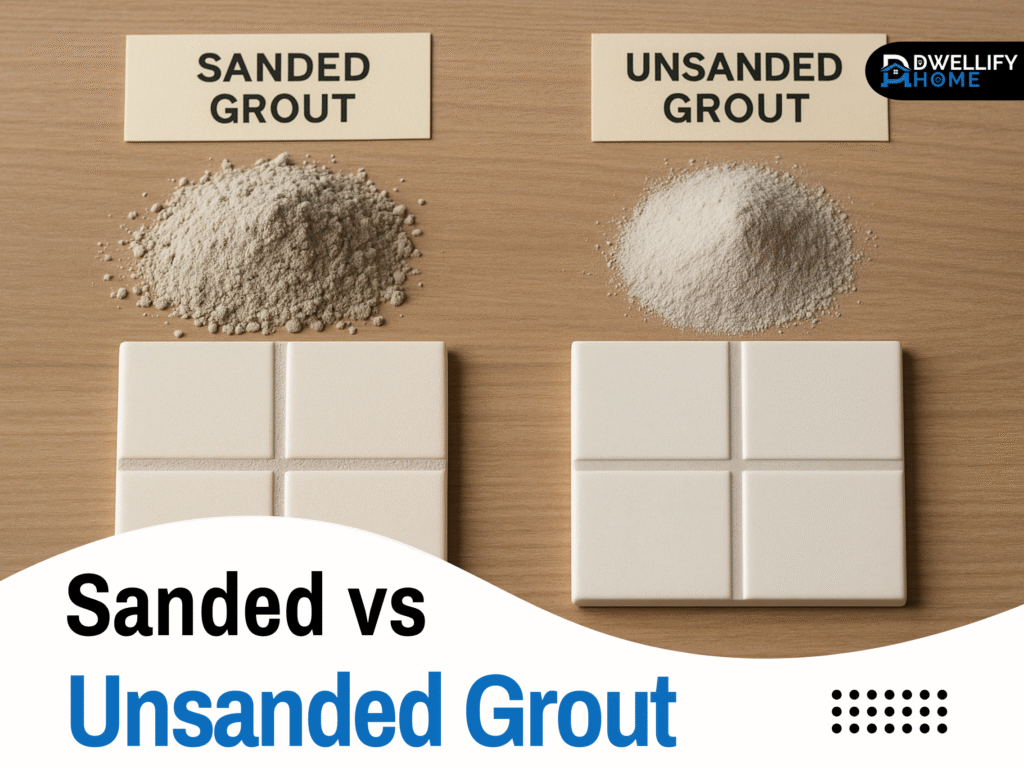If you’ve ever started a tiling project, you already know that choosing the tile is the fun part. But when it comes time to pick the grout, things get confusing fast. One of the most common questions people ask is: should I use sanded or unsanded grout?
Here’s the thing — grout might not look like a big deal, but it plays a huge role in how your tile job looks, feels, and lasts. The wrong grout can crack, shrink, or even damage your tiles. I remember when I first tiled my bathroom floor, I thought all grout was the same. Let’s just say I learned the hard way when my joints started crumbling a few months later.
Short Definition:
Sanded grout contains fine sand for strength, best for joints wider than 1/8 inch. Unsanded grout is smooth, won’t scratch delicate tiles, and is ideal for narrow joints, vertical walls, and polished surfaces.
In this guide, I’ll walk you through everything you need to know about sanded vs unsanded grout. We’ll look at what they’re made of, when to use each one, the pros and cons, and even some expert-backed tips from real installers and DIYers. By the end, you’ll feel confident picking the right grout for your shower, backsplash, floor, or any other tiling project.
Mission Statement
Our mission is to provide homeowners, DIY renovators, and tile professionals with clear, practical, and trustworthy guidance on choosing the right grout. By blending expert knowledge with real-world tips, we help you make confident decisions that ensure your tile projects are durable, beautiful, and built to last.
What Is Grout and Why Does the Type Matter?
Grout is the filler that goes between your tiles. It locks the tiles in place, protects against moisture, and gives the surface a finished look. You can think of it as the glue that also acts as a seal between each tile.
Now, why does the type matter? Because grout isn’t just about appearance — it affects the strength and longevity of your tile installation. Use the wrong kind, and you might end up with cracked lines, loose tiles, or scratched surfaces. That’s why professionals always say, “match the grout to the job, not just the tile.”
Another thing people don’t realize is that grout also impacts style. The color and texture can make your tile design pop or blend in seamlessly. Whether you go with sanded or unsanded will affect how smooth the lines look and how durable they feel under daily use.
Sanded vs Unsanded Grout: The Core Difference
Composition and Texture
The names make it pretty straightforward. Sanded grout has fine sand mixed in, while unsanded grout doesn’t. That little detail changes everything.
Sanded grout feels a bit rough and gritty because of the sand particles. This gives it extra strength, making it ideal for wider grout lines and areas that take a beating, like kitchen floors or entryways.
Unsanded grout, on the other hand, is smooth and creamy. It spreads easily and finishes neatly without any grit. That makes it a go-to choice for delicate tiles, like polished marble or glass, because it won’t scratch the surface.
How Materials Affect Performance
That tiny ingredient difference impacts how the grout behaves once it dries. Sanded grout doesn’t shrink much, so it holds up well in wide joints. Unsanded grout, because it lacks the sand, can shrink more as it cures — which is why it struggles in wider gaps.
Here’s a quick way to think about it:
- Sanded = strength, durability, wider spaces.
- Unsanded = smooth finish, delicate tiles, narrow spaces.
I once helped a friend redo his backsplash with glossy glass tiles. He accidentally grabbed sanded grout, and guess what? The surface ended up with tiny scratches that ruined the shine. That’s the kind of mistake you’ll definitely want to avoid.
When to Use Sanded vs Unsanded Grout (By Application)
Here’s the golden rule every tile pro swears by: grout choice depends mainly on joint width and tile type. Once you understand those two things, most of the confusion disappears.
Grout Joint Width Rules
If your grout joints are narrow — less than 1/8 inch — you’ll want to go with unsanded grout. It flows into those tiny spaces more easily and bonds without leaving voids. Unsanded also gives you that smooth, clean look that makes small joints almost invisible.
For joints that are 1/8 inch or wider, sanded grout is usually the better option. The sand keeps the grout from shrinking too much as it cures and adds strength to hold everything in place. That’s why sanded grout is the go-to for floors, especially in areas with heavy foot traffic.
Think of it this way:
- Small gaps → unsanded.
- Big gaps → sanded.
Simple, but super important.
Tile Surface Type
The material of your tile also plays a big role. If you’re working with delicate surfaces — like glass, polished marble, or natural stone — unsanded is the safer choice because it won’t scratch the surface during application.
On the flip side, tougher materials like ceramic, porcelain, and textured stone are totally fine with sanded grout. In fact, they benefit from it because those wider, rougher joints need extra durability.
Surface Orientation: Vertical vs Horizontal
Another overlooked detail is whether your tiles are on a wall or on the floor. Unsanded grout sticks better on vertical surfaces like shower walls or kitchen backsplashes, where sanded grout might slump or fall out before it sets.
For floors, sanded grout is king. It’s tougher, resists cracking, and can handle daily wear and tear. I once redid a kitchen floor with unsanded grout (against my better judgment), and within a year, the lines had cracked in multiple places. Lesson learned: always respect the joint width and the surface type.
Sanded vs Unsanded Grout for Specific Areas
Now that we’ve covered the general rules, let’s look at common spaces in your home where you’ll face the sanded vs unsanded decision.
Sanded vs Unsanded Grout for Shower
Showers are tricky because they combine vertical and horizontal surfaces. For shower walls, unsanded grout usually works best — the joints are narrow, and it sticks well without slumping. Plus, you avoid scratching delicate tiles like glass mosaics that are often used in showers.
For shower floors, sanded grout is typically the winner. Floors take constant water exposure and foot traffic, so the durability of sanded grout makes a big difference. If you’ve got small mosaic tiles on the shower floor, though, you’ll want to double-check joint width and possibly use unsanded or even epoxy grout.
Sanded vs Unsanded Grout for Floor
Floors see heavy use, which means they need strength. That’s where sanded grout shines. It resists cracking in wide joints and holds up well under foot traffic. Unsanded grout can still be used on floors, but only if you’ve got very narrow joints (like in certain decorative patterns). Even then, it’s not as tough in the long run.
I remember tiling a friend’s entryway with sanded grout in a dark color. Five years later, it still looks solid, even though it’s the most used path in his house. That’s the kind of performance you want for a floor.
Sanded vs Unsanded Grout for Backsplash
Backsplashes are usually made up of smaller, decorative tiles with tighter joints. That makes unsanded grout the smarter choice. It flows smoothly between narrow spaces and gives a polished finish. Sanded grout here can be messy, leaving uneven lines that don’t look great against small or shiny tiles.
That said, if you’re using larger subway tiles with wider gaps, sanded grout might still work. Just remember: backsplash = more about looks than strength, so smooth is often better.
Sanded vs Unsanded Grout for Mosaics
Mosaic tiles almost always mean very small grout joints. Unsanded grout is the safer choice because it can easily fill those tiny gaps and won’t scratch decorative finishes. For glass mosaics, it’s basically non-negotiable — always go unsanded.
But here’s a pro tip: if your mosaics are in high-moisture or high-traffic areas (like a shower floor), consider epoxy grout. It’s pricier, but it’s waterproof, stain-resistant, and incredibly durable.
Sanded or Unsanded Grout for Porcelain Tile
Porcelain is a durable material that can handle sanded grout without issue. If your joints are wider than 1/8 inch, sanded is the way to go. If the joints are narrow, unsanded will give you cleaner lines.
One thing to note: porcelain often comes in large-format tiles, which means thinner joints are common. That’s where unsanded grout really helps achieve that seamless, modern look.
Sanded vs Unsanded Grout Caulk and Transitions
Grout isn’t always enough on its own. In areas where tiles meet different surfaces — like the corner of a shower or where the backsplash meets the countertop — you’ll want to use caulk instead of grout.
Caulk allows for a little movement without cracking. Both sanded and unsanded caulk options exist to match your grout type. The key is to use grout in the joints and caulk in the flexible transition areas. That way, your project stays strong and looks professional.
Pros and Cons of Each Type
No matter how many guides you read, sometimes the easiest way to decide is to see the pros and cons side by side. Let’s break it down.
Sanded Grout Pros and Cons
Pros
- Stronger and more durable, especially for wider joints.
- Less prone to shrinkage as it dries.
- Holds up well in high-traffic areas like kitchens, hallways, and entryways.
- Generally more affordable than unsanded grout.
- Wide range of color options available.
Cons
- Can scratch delicate surfaces like glass, polished marble, or metal tiles.
- Slightly rough texture, which can make it harder to clean.
- Doesn’t work well in joints smaller than 1/8 inch — it won’t pack in properly.
- Can be tricky to use on vertical surfaces, since it tends to slump.
Unsanded Grout Pros and Cons
Pros
- Smooth, creamy texture that gives a clean finish.
- Won’t scratch delicate or glossy tiles like glass or polished stone.
- Perfect for narrow joints under 1/8 inch.
- Sticks well to vertical surfaces (like shower walls and backsplashes).
Cons
- Not as durable as sanded grout in wider joints.
- More prone to shrinking and cracking when used in large gaps.
- Often more expensive than sanded grout.
- Limited color options compared to sanded versions.
Here’s the takeaway: if strength and durability are your top concerns, sanded grout wins. If you care more about protecting delicate surfaces and getting a smooth, polished look, unsanded grout is the safer bet.
Expert Tips and DIY Insights
Over the years, I’ve learned that grout isn’t just about what you buy — it’s about how you use it. Here are some practical, real-world tips that can save you from common mistakes.
Match Grout to Joint Size and Tile Type
This one sounds obvious, but it’s the number one mistake I see. People grab whatever grout is on sale or in stock, without checking the joint width. Trust me, using unsanded grout in wide joints is a recipe for cracking. Always measure your tile gaps before buying.
Follow Manufacturer Recommendations
Tile makers often suggest which grout works best with their product. If you’re installing natural stone, polished marble, or specialty tiles, always double-check their guidelines. Sometimes they even recommend specific grout brands, like Mapei grout, that pair best with their materials.
Learn from Real Installers (and Mistakes)
I can’t tell you how many times I’ve seen discussions on tiling forums and even on Reddit where DIYers regret using sanded grout on delicate glass tiles. The scratches might be tiny, but once the light hits them, they stand out like crazy. On the flip side, pros will tell you sanded grout is a lifesaver for floors and heavy-use areas. Listen to the people who’ve made the mistakes already — it’ll save you time and money.
Application and Mixing Tips
- Don’t add too much water when mixing — it weakens the grout and causes pinholes.
- Use the right float: rubber floats are ideal for smooth application.
- Pack the grout firmly into the joints to avoid air pockets.
- Always clean as you go. If you let grout haze dry on tile, it’s a nightmare to remove.
Sealing and Maintenance
Both sanded and unsanded grout need sealing (unless you go with epoxy grout). A good penetrating sealer will protect against water, mold, and stains. Plan to reseal every year or two in bathrooms or kitchens. It’s one of those small chores that pays off big time by keeping grout lines looking fresh.
Cost vs Longevity
Unsanded grout may cost a little more upfront, but if you’re using it in delicate areas where sanded would scratch, it’s worth every penny. For floors or outdoor spaces, sanded grout saves money and lasts longer — so you won’t be regrouting anytime soon.
Comparison Table
| Feature | Sanded Grout | Unsanded Grout |
| Texture | Gritty, contains fine sand | Smooth, no sand |
| Best For | Joints ≥ 1/8 inch, floors, high traffic | Joints ≤ 1/8 inch, walls, delicate tiles |
| Tile Type | Ceramic, porcelain, stone | Glass, polished marble, metal tiles |
| Durability | Stronger, less shrinking | Can shrink in wide joints |
| Scratch Risk | Can scratch polished surfaces | Safe for delicate surfaces |
| Vertical Surfaces | Harder to apply | Better adhesion |
| Cost | Usually cheaper, more color options | More expensive, limited colors |
Quick Step-by-Step Guide to Choosing Grout
- Measure your grout joint width.
- Narrow (≤ 1/8 inch) → unsanded.
- Wide (≥ 1/8 inch) → sanded.
- Check your tile type.
- Delicate/glossy → unsanded.
- Durable/porous → sanded.
- Consider the surface orientation.
- Walls/backsplashes → unsanded.
- Floors/high-traffic areas → sanded.
- For extra durability or moisture resistance, consider epoxy grout.
Beyond Sanded and Unsanded: Alternative Options
Sometimes neither sanded nor unsanded grout feels like the right fit. That’s when alternatives come in handy.
Epoxy Grout
Epoxy grout is a game changer in certain situations. It’s made from resin instead of cement, which makes it:
- Waterproof (perfect for showers and kitchens).
- Highly stain-resistant (red wine, grease, or coffee won’t seep in).
- Super durable, lasting years longer than traditional grout.
The downside? It’s harder to apply, sets quickly, and costs more. But if you’re working with mosaics in a shower floor or want long-term peace of mind, epoxy grout is worth considering.
Polymer-Modified Grout
This type of grout is strengthened with polymers, giving it better adhesion and flexibility. It’s kind of a middle ground between traditional sanded/unsanded and epoxy. Many modern grout products are polymer-modified for better performance.
Wide-Joint or Specialty Grouts
For very wide joints (over 3/8 inch), there are specialized grouts designed specifically for that purpose. Sanded grout can handle a lot, but once the gap gets too wide, you’ll need something with more body to hold up.
Additional Considerations That Really Matter
When most people think about grout, they focus only on sanded vs unsanded. But there are a few other details that can make or break your project.
Grout Color and Aesthetic Impact
Grout color isn’t just about style — it can completely change how your tile job looks. Light-colored grout tends to make tiles blend together, giving you a seamless surface. Darker grout creates contrast, which can highlight patterns like subway tile or mosaics.
Here’s the thing: the sand in sanded grout can sometimes make the color look a little more textured or “grainy.” Unsanded grout, being smoother, usually gives a cleaner and more even color finish. If you’re after sleek, modern lines, unsanded might be your best bet. For rustic or natural stone looks, sanded grout blends in more naturally.
A tip from experience: always do a small test area with your chosen grout color before committing. I once picked a “light gray” sanded grout for a bathroom floor, only to realize it dried much darker than expected. Testing saves you from costly surprises.
Moisture and Traffic Considerations
Bathrooms, kitchens, and outdoor spaces all put grout to the test. Moisture, spills, and constant traffic can wear grout down faster than you’d think.
- Bathrooms and showers: Unsanded works for narrow vertical joints, but sanded or epoxy grout is best for floors where water sits.
- Kitchens: Floors and backsplashes face food stains, so sealing is non-negotiable. Epoxy grout is ideal near sinks or stovetops.
- Outdoor areas: Only sanded or epoxy grout should be used here, since weather changes cause expansion and contraction.
If you’re planning for long-term durability in a wet or high-traffic spot, epoxy grout may be worth the higher cost.
Maintenance and Re-Grouting
Even the best grout won’t last forever. Over time, you’ll notice discoloration, mold, or even small cracks. When that happens, it may be time to re-grout.
Sanded grout tends to last longer in busy areas, while unsanded might need attention sooner if used in places it wasn’t meant for. Sealing your grout properly can double its lifespan.
Here’s my maintenance routine that works well:
- Wipe down grout lines weekly with a gentle cleaner.
- Reseal every 1–2 years in moisture-heavy rooms.
- Avoid harsh chemicals — they strip sealers and weaken grout.
Environmental and Safety Aspects
These days, more homeowners are thinking about eco-friendly materials. Some grout products release VOCs (volatile organic compounds), especially during mixing. Look for low-VOC or eco-labeled options if air quality is a concern.
Another thing to consider is anti-mold additives. Some modern grouts (including polymer-modified and epoxy options) come with built-in protection against mildew. If you’re grouting a shower or basement floor, that extra feature is worth it.
Case Studies and Real-Life Lessons
I once helped a client who had used unsanded grout on a large-format porcelain floor. It looked great for the first few months, but by the one-year mark, the grout had cracked in multiple spots. We had to re-do the entire job with sanded grout — an expensive redo that could’ve been avoided.
On the flip side, I’ve seen projects where the right grout made all the difference. A glass mosaic backsplash with unsanded grout still looked flawless years later because the installer chose correctly. These real-world examples show that it’s not just theory — the right choice matters.
Tools and Materials Checklist for Proper Grouting
Before you start, make sure you’ve got the essentials:
- Grout (sanded or unsanded, or epoxy if needed)
- Grout float (rubber is best for smooth application)
- Mixing bucket and margin trowel
- Sponge and clean water
- Grout sealer
- Caulk for corners and transitions
Having the right tools makes the job smoother and helps you get a professional finish.
Frequently Asked Questions
Can I use unsanded grout on floor tiles?
Yes, but only if the joints are narrow (under 1/8 inch). For wider joints, it won’t hold up to foot traffic and will likely crack.
What happens if I use the wrong grout type?
Using sanded grout on delicate tiles can scratch them permanently. Using unsanded grout in wide joints can lead to cracks and shrinking. Neither outcome is fun to fix.
Do I always need to seal grout?
Yes, unless you’re using epoxy grout. Sealing protects against stains, moisture, and mold. Think of it as insurance for your grout lines.
How do I choose grout color?
Pick a color that complements your tile and the look you want. For seamless designs, match tile and grout colors. For bold looks, choose a contrasting grout.
Can I mix sanded and unsanded grout?
Not a good idea. Each type is designed for specific uses. Mixing them won’t give you the best of both worlds — just weaker performance.
Which grout brand is best?
Brands like Mapei and Laticrete are trusted by pros. The best one for you depends on availability, tile type, and whether you need sanded, unsanded, or epoxy options.
Conclusion
At the end of the day, the choice between sanded vs unsanded grout comes down to a simple formula:
- Joint width — under 1/8 inch, go unsanded. Wider than that, go sanded.
- Tile type — delicate tiles need unsanded, durable tiles are fine with sanded.
- Surface — walls prefer unsanded, floors demand sanded.
And if you want the ultimate upgrade, epoxy grout is the long-lasting, waterproof option.
Here’s my advice: don’t cut corners on grout. It’s easy to overlook, but it’s the backbone of a good tile job. Choose carefully, apply it right, and seal it well. Do that, and your tiles will look great and last for years.
I’ve made the mistakes so you don’t have to. Trust me, the difference between sanded and unsanded grout isn’t just in the name — it’s in the results you’ll see every single day.
Disclaimer
This article is for informational purposes only. While we’ve included expert insights and practical advice, always follow manufacturer instructions and consult a professional for complex installations. We are not responsible for any project outcomes resulting from misuse or misapplication of grout products.

I’m Bilal, the founder of Dwellify Home. With 6 years of practical experience in home remodeling, interior design, and décor consulting, I help people transform their spaces with simple, effective, and affordable ideas. I specialize in offering real-world tips, step-by-step guides, and product recommendations that make home improvement easier and more enjoyable. My mission is to empower homeowners and renters to create functional, beautiful spaces—one thoughtful update at a time.




